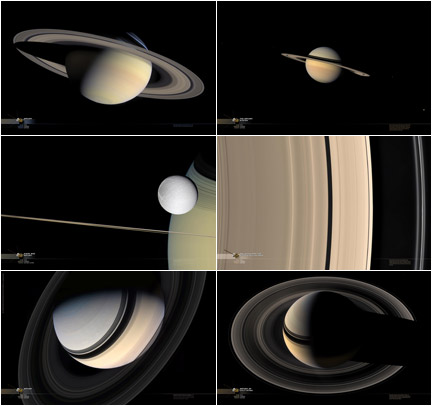Among the various worlds in our celestial neighborhood, Saturn stands apart as a most photogenic. With the help of a complex system of rings it naturally lends itself to more scenic images as compared to the more detail oriented images we see from such other places such as Mars or Jupiter. The “Saturn Scenes” set (downloadable here as a zipped file) was compiled from some of the best scenic images from the Cassini mission that had the potential to fill a 2560x1600 frame.

In order to completely fill that frame out some rendering and sampling has been applied to the original images. These additions are briefly noted in the images themselves and are as noted here…
DIONE AND SATURN features the moon Dione passing in front of the edge of Saturn’s disc. The original image would only fill about 1/4 of the frame so some of the details have been sampled and expanded to fill out that full frame’s proportions. The details of the rings are sampled from this image and based upon other photographic references. The left 2/3 of the rings seen here were rendered and are not actual. The lower 1/5 of Saturn’s disc was sampled and extended from the original image. Lastly, the top darkest ring shadows were rendered based upon a fair amount of actual data that was actually present in the original but was cropped short.
SATURN (which is named “SATURN-2.jpg” in the file name) has had a considerable amount of rendering to extend the details of the rings to fill out this larger 2560x1600 frame. The original color composite work was masterfully performed by Ian Regan for unmannedspaceflight.com and has become a wanderingspace favorite. In order to extend the rings to fill out the frame as accurately as possible, a one pixel wide sampling of the full set of rings was captured and digitally translated to vectors. These vectors were then stretched and applied to a circle path which was then rendered in 3-D software to achieve the correct perspective of the original. Once a match was made, the new vector based rings were then blended into the actual original image and some masking was applied to represent Saturn’s shadow falling upon the rings. Despite the heavily rendered nature of the rings, virtually no part of the disc of Saturn itself has been altered and is 99.5% original and actual.
All other images are actual and unaltered.